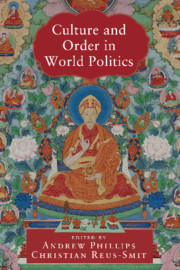Book contents
- Culture and Order in World Politics
- LSE International Studies
- Culture and Order in World Politics
- Copyright page
- Contents
- Additional material
- Contributors
- Preface
- Part I Introduction
- Part II Historical Orders
- Part III The Modern ‘Liberal’ Order
- Part IV Constitution and Contestation
- 10 Universal and European
- 11 The Jewish Problem in International Society
- 12 Recognizing Diversity
- 13 Gender, Nation and the Generation of Cultural Difference across ‘The West’
- 14 Governing Culture ‘Credibly’
- Part V Conclusion
- References
- Index
11 - The Jewish Problem in International Society
from Part IV - Constitution and Contestation
Published online by Cambridge University Press: 25 December 2019
- Culture and Order in World Politics
- LSE International Studies
- Culture and Order in World Politics
- Copyright page
- Contents
- Additional material
- Contributors
- Preface
- Part I Introduction
- Part II Historical Orders
- Part III The Modern ‘Liberal’ Order
- Part IV Constitution and Contestation
- 10 Universal and European
- 11 The Jewish Problem in International Society
- 12 Recognizing Diversity
- 13 Gender, Nation and the Generation of Cultural Difference across ‘The West’
- 14 Governing Culture ‘Credibly’
- Part V Conclusion
- References
- Index
Summary
Barnett uses the 'Jewish Problem' to compare how different kinds of nationalism have offered different ways of dealing with minorities and, in turn, the strategies available to minorities who want to both retain their community and maintain their physical survival. Nineteenth-century Europe developed two different kinds of nationalism that had different responses to the minorities in their midst. Western ‘civic’ conceptions of the nation offered minorities the ability to integrate if they accepted that they were part of the civic nation. Eastern 'ethnic' nationalism could not imagine minorities such as the Jews as being a candidate for membership in the nation. In response to the opportunities offered by countries with civic nationalism, Jews 'reformed' Judaism and their Jewish identities so that it could fit into a broader Christian, liberal society. For Eastern Jews, there was no possibility of integration, forcing then to flee, turn to broader transnational movements such as socialism, or develop their own brand of Jewish nationalism, best known as Zionism.
Keywords
- Type
- Chapter
- Information
- Culture and Order in World Politics , pp. 232 - 249Publisher: Cambridge University PressPrint publication year: 2020



